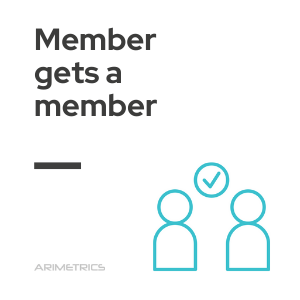
Definition
Member Gets a Member is a marketing strategy that involves incentivizing existing customers or members of a company to attract new clients. This strategy is based on brand loyalty and motivation through incentives. By harnessing the power of recommendations from existing customers, companies can effectively promote their products or services.
This technique is considered highly effective because customer recommendations generate a high degree of trust among new recipients. Additionally, it contributes to customer retention, which is a fundamental aspect of marketing, as the cost of acquiring a new customer is often significantly higher than that of retaining an existing one.
How to make a Member Gets a Member campaign
If we want to carry out an effective Member Gets a Member campaign we must develop a strategy previously taking into account the following considerations:
- Contextualization according to the company: Each company has its own characteristics and circumstances. When designing a strategy to attract new customers, it is important to consider the particularities of the business and adapt actions accordingly. For example, the priorities of a watch company may differ significantly from those of a restaurant, requiring a sector-specific approach.
- Offer incentives: Offering incentives to customers for recruiting new members is one of the most effective tactics in this type of campaign. Incentives can vary, including products, services, discounts or company-related promotions. This approach not only motivates existing customers to participate, but can also induce new customers to join and help drive leads for the company.
- Make access easy: To maximize participation, it is critical that both the incentives and the program objectives are easily attainable. Making the campaign easy to share via apps and social media is one aspect that can increase the effectiveness of the strategy.
Benefits of using Member Gets a Member
The Member Gets a Member strategy offers multiple benefits for companies looking to expand their customer base and strengthen the loyalty of existing customers. Below are some of the main benefits of this marketing technique:
- Increased consumer trust: Recommendations from friends and family are often more credible than traditional advertising. By leveraging the voice of existing customers, companies can build trust and credibility among new prospects, facilitating the purchase decision.
- Customer loyalty: By involving existing customers in the process of attracting new users, a sense of belonging and loyalty to the brand is fostered. Customers who participate in such programs tend to feel more valued and engaged, which can result in higher retention.
- Reduced acquisition costs: Acquiring new customers through referrals can be less expensive than traditional marketing strategies, such as paid advertising. Incentives offered to existing customers are often less costly than the expenses associated with advertising campaigns.
- Expansion of the client network: Each new customer referred has the potential to bring in more referrals, which can result in exponential growth of the customer base. This network effect can help companies reach a wider audience organically.
- Better market segmentation: By using existing customers to attract new users, companies can benefit from better segmentation. Existing customers tend to know people with similar interests, which means that referrals are more likely to become customers.
- Valuable feedback: Member Gets a Member programs can provide valuable information about what customers value in the brand. Companies can use this feedback to improve their products, services and marketing strategies.
- Increased conversion rate: Customer recommendations tend to have a higher conversion rate compared to other customer acquisition methods. This is due to the trust that new customers place in recommendations from people they know.
Member Gets a Member campaign success stories
There are numerous companies that have successfully implemented the Member Gets a Member strategy, achieving significant results in attracting new customers. Some examples include:
- Dropbox: This cloud storage platform launched a referral campaign that offered free additional space to users who invited friends to sign up. As a result, Dropbox experienced explosive growth in its user base, increasing its number of signups by 60% in just one month.
- Airbnb: The vacation rental company implemented a referral program where both the referral and the inviting user received a credit to their account. This strategy not only incentivized existing users to invite friends, but also helped build a strong and loyal community around the platform.
- Uber: Uber has used a referral program that allows users to get discounts on their rides by inviting new users to sign up. This approach has contributed to the steady growth of its customer base and has fostered loyalty among existing users.
Challenges in implementing Member Gets a Member
Despite the potential benefits, Member Gets a Member campaigns can also present challenges that companies should consider:
- Market saturation: In an environment where many companies use referral programs, consumers can become indifferent to offers. It is important for campaigns to be creative and offer incentives that really resonate with customers.
- Quality control: When incentivizing customers to attract new users, there is a risk of generating low-quality referrals. Companies must ensure that new members are truly relevant and aligned with their target audience.
- Maintaining loyalty: While a Member Gets a Member program can attract new customers, companies must work to maintain the loyalty of existing customers. If customers feel they are only valued for their referrals, it can negatively affect their perception of the brand.
- Measuring success: Evaluating the effectiveness of a Member Gets a Member campaign can be complicated. Companies must establish clear metrics and tracking tools to measure the impact of their efforts and adjust their strategies accordingly.
